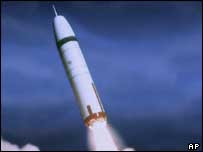Wednesday’s Roll-up of Missile Items: Conventional TRIDENT gets the axe
OK – so why the perceived need for a conventional variant of a nuclear missile? Time. Time is a precious commodity when dealing with certain threats. Tomahawks are subsonic, strike or bomber aircraft carry their own inherent limitations (consider that a round trip for a B2 mission to Kosovo was 30 hours from stateside bases) and there are some areas that are effectively denied due to political considerations or otherwise that prevent overflight.
The kind of scenarios a conventional SLBM/ICBM would be in include a pre-emptive strike, for example, against a mobile IRBM that is being positioned for launch or a high value terrorist target that is located via an unarmed UAV that is in danger of fleeing – these represent some of the time-critical target sets that are usually used in justifying a conventional SLBM/ICBM capability. The warhead need be no more complicated than an inert RV – the kinetic energy of the strike will generate enough damage, assuming appropriate CEP, of the target.
If there is such utility and need, why the concern? There are several points of contention, beginning with the difficulty in distinguishing between a conventional and traditionally nuclear capable missile. The concept of dual use is not new – it has been present since the dawn of the nuclear age where aircraft are concerned. B-52s regularly carried conventional bomb loads in Vietnam during the timeframe when nuclear-armed B-52s were standing alert at Minot AFB. The thing is, those conventionally armed B-52s didn’t launch out of Minot for North Vietnam, fly the profile/track the nuclear armed BUFFs would in attacking the Soviet Union and did not overfly portions of the Soviet Union or China enroute to North Vietnam.
Eventually there were visible modifications made under START to B-52s and other dual purpose aircraft that would distinguish the one from the other (more for START counting purposes than anything else). Not so with conventional SLBM/ICBMs – a TRIDENT or MINUTEMAN coming out of its launcher appears indistinct from its nuclear counterpart. The early warning systems of Russia and China would alert on, detect, track and react as if it were a nuclear missile. Of course, one could argue that prior notification should/could be given to those countries and others who might be affected by overflight (assuming they could detect it), but that portends compromise of sensitive data as well as injecting delays into the process. Finally, it also mandates air-tight intel owing not only to the cost of the asset being employed, but the wealth of potential political fallout that would result from its use.


